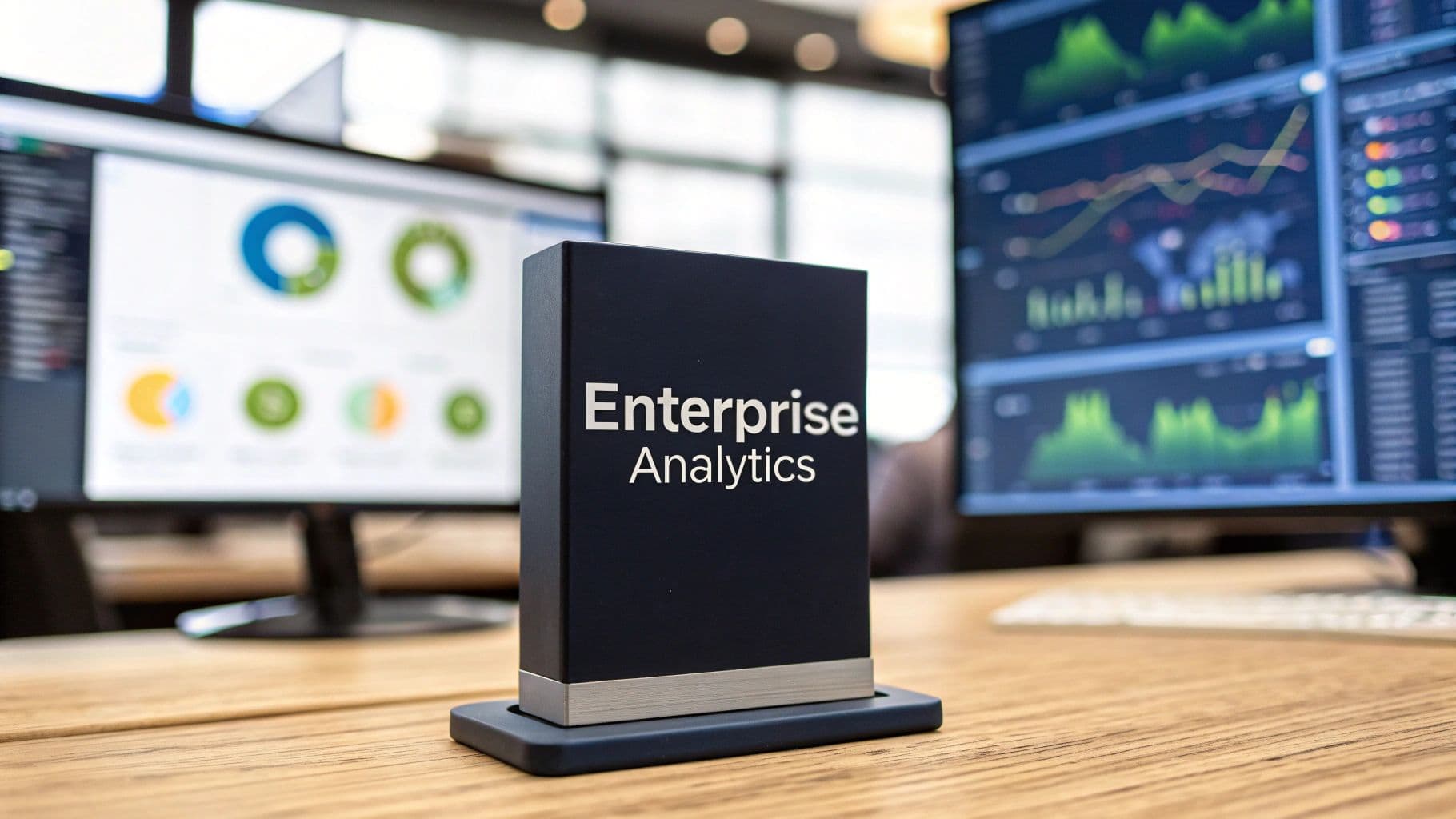9 Critical Data Integration Best Practices for 2025
Discover the top 9 data integration best practices for SaaS product teams. Learn expert strategies for governance, scalability, quality, and performance.

In the competitive SaaS landscape, product intelligence teams are tasked with converting massive streams of customer feedback and usage data into revenue-driving decisions. From Zendesk tickets and Intercom chats to app usage metrics and Gong sales calls, the raw information is abundant. However, connecting these disparate sources into a cohesive, actionable whole presents a significant hurdle.
Inefficient data pipelines, inconsistent quality, and siloed information don't just create friction; they lead directly to misguided product roadmaps, increased customer churn, and overlooked growth opportunities. This is precisely why mastering the art and science of data integration is no longer a "nice-to-have" but a core strategic imperative. Adopting a robust set of data integration best practices is not merely a technical exercise for engineers. It is the fundamental blueprint for building a data-driven culture that enables your team to understand user needs deeply, iterate faster, and consistently outmaneuver the competition.
This guide moves beyond generic advice to provide a comprehensive roundup of nine essential, actionable practices designed specifically for product intelligence. We will cover everything from establishing clear governance and designing for scalability to implementing robust security and optimizing performance. By the end, you will have a clear framework for transforming your scattered raw data into your most powerful strategic asset, empowering your teams to make smarter, faster decisions that fuel sustainable growth. Let's dive into the essential practices that will fortify your data foundation.
1. Establish Clear Data Governance and Ownership
Data governance is the foundational framework that ensures your data is managed as a strategic asset. It involves establishing clear policies, procedures, and accountability structures to maintain data quality, security, and compliance throughout the entire integration lifecycle. This practice defines who owns what data, who can access it, and what standards must be upheld across all systems, making it an indispensable first step in any successful data integration strategy.
Without robust governance, data integration can lead to a "garbage in, garbage out" scenario, where poor quality data from one system corrupts the analytics and operations of another. A well-defined governance model prevents this by creating a single source of truth and instilling trust in the data used for decision-making.

Why It's a Key Data Integration Best Practice
For SaaS product intelligence teams, clear governance and ownership are critical. When integrating data from various sources like CRMs, product analytics tools, and customer support platforms, a lack of governance can result in inconsistent metrics, data security vulnerabilities, and compliance risks (e.g., GDPR, CCPA). For instance, General Electric successfully leveraged a centralized data stewardship model to drive its digital transformation, ensuring data consistency and reliability across its vast industrial operations.
Actionable Implementation Steps
To effectively implement data governance, follow these structured steps:
- Assign Data Stewards: Designate individuals or teams as "data stewards" for specific data domains (e.g., customer data, product usage data). These stewards are responsible for defining data quality rules, managing access controls, and resolving data issues.
- Create a Data Catalog: Develop a centralized data catalog with a business glossary. This catalog should document data lineage, definitions, and ownership, making it easy for analysts and product managers to find and understand the data they need.
- Implement Automated Monitoring: Use tools to automate data quality checks and monitoring. Set up alerts to notify data stewards of anomalies, such as unexpected null values or format inconsistencies, ensuring issues are addressed proactively.
- Establish Governance Councils: Form a data governance council with representatives from different business units. This group should meet regularly to review policies, address cross-functional data challenges, and align on data strategy.
2. Design for Scalability and Performance
Designing for scalability and performance means architecting data integration solutions that can handle growing data volumes, increasing user loads, and evolving business requirements without significant performance degradation. This forward-looking approach involves building systems that can expand capacity and maintain speed, ensuring your data pipelines remain efficient as your business grows. It's a crucial practice for avoiding bottlenecks and future-proofing your data infrastructure.
Without a scalable design, an integration solution that works today may fail under the pressure of tomorrow's data deluge. By planning for growth from the outset, you prevent costly redesigns and ensure that your data-driven insights remain timely and reliable.

Why It's a Key Data Integration Best Practice
For SaaS product intelligence teams, a scalable architecture is non-negotiable. As user bases expand and product features multiply, the volume of event data can grow exponentially. A system not built to scale will quickly become overwhelmed, leading to slow queries, delayed reports, and missed opportunities. For example, Spotify’s real-time data pipeline processes over 100TB of data daily, a feat made possible by a scalable, Kafka-based streaming architecture that supports personalized recommendations and artist analytics for millions of users worldwide. This commitment to scalable design is a core component of effective enterprise data analytics on sigos.io.
Actionable Implementation Steps
To build a scalable and high-performance data integration framework, focus on these steps:
- Leverage Cloud-Native Services: Utilize elastic services from cloud providers like AWS (e.g., Kinesis, Lambda) or Google Cloud (e.g., BigQuery, Dataflow). These services automatically scale resources up or down based on demand, providing cost-effective performance.
- Implement Data Partitioning: From the beginning, partition large datasets based on logical keys like date or customer ID. This allows parallel processing and significantly improves query performance by reducing the amount of data scanned.
- Design with a Microservices Architecture: Break down monolithic integration jobs into smaller, independent microservices. This approach allows individual components to be scaled independently, improving fault tolerance and making maintenance easier.
- Plan for Peak Load Scenarios: Design your system to handle peak traffic, not just average load. Conduct load testing to identify potential bottlenecks before they impact production, ensuring reliability during critical business periods.
3. Implement Comprehensive Data Quality Management
Data quality management is the systematic process of ensuring data is accurate, complete, consistent, and reliable throughout its entire lifecycle. It involves establishing validation rules, cleansing procedures, and continuous monitoring to maintain the integrity of data as it moves between systems. This practice is crucial for preventing flawed insights and operational errors that arise from unreliable information.
Effective data quality management transforms raw data into a trustworthy asset, ensuring that analytics, reporting, and AI-driven features are built on a solid foundation. Without it, even the most sophisticated data integration architecture will fail to deliver value, propagating errors that can lead to poor business decisions and a loss of user trust.

Why It's a Key Data Integration Best Practice
For SaaS product intelligence, high data quality is non-negotiable. Integrating flawed customer behavior data or incomplete subscription information can lead to inaccurate churn predictions and misguided feature development. By implementing a robust quality framework, teams can ensure their insights are dependable. For instance, PayPal relies on a real-time data quality system to power its fraud detection algorithms, where data accuracy is critical for identifying and preventing fraudulent transactions without disrupting legitimate user experiences.
Actionable Implementation Steps
To build a comprehensive data quality management process, follow these structured steps:
- Define Quality Rules at the Source: Establish data quality rules and validation checks within the source systems before integration begins. This prevents bad data from entering the integration pipeline in the first place, reducing downstream cleansing efforts.
- Implement Checks at Multiple Integration Points: Don't just check data at the source. Implement validation, transformation, and enrichment checks at various stages of your ETL/ELT pipeline to catch inconsistencies that may arise during processing.
- Establish Quality Scorecards and Reporting: Create data quality dashboards and scorecards that measure key metrics like completeness, accuracy, and timeliness. Regularly report these scores to business stakeholders and data owners to create transparency and accountability.
- Create Feedback Loops to Source System Owners: When data quality issues are detected, implement an automated feedback loop that notifies the owners of the source system. This enables them to correct the data at its origin, addressing the root cause of the problem.
4. Choose the Right Integration Architecture Pattern
Selecting the most appropriate integration architecture is a critical decision that dictates how data flows between your systems. This practice involves choosing a specific pattern, such as ETL/ELT, real-time streaming, or API-driven integration, based on your business requirements, data volume, and performance needs. The right pattern ensures your data integration is efficient, scalable, and maintainable.
Choosing an architecture isn't a one-size-fits-all solution; it's a strategic trade-off. A pattern that excels for batch analytics might fail for real-time fraud detection. Making an informed choice early on prevents costly re-architecting and ensures your infrastructure can support your product intelligence goals both now and in the future.

Why It's a Key Data Integration Best Practice
For SaaS product teams, the choice of integration architecture directly impacts the user experience and analytical capabilities. For instance, Netflix famously uses a Lambda architecture that combines batch processing for comprehensive analytics with stream processing for real-time recommendations. This hybrid model allows them to deliver both deep insights and immediate value to users. An incorrect choice could lead to data latency, poor system performance, and an inability to scale as user and data volumes grow, making this one of the most vital data integration best practices to get right.
Actionable Implementation Steps
To select and implement the right architecture, consider the following structured steps:
- Assess Latency Requirements: Determine if your use case requires batch, near-real-time, or real-time data. For historical reporting, a daily ETL batch process may suffice, while in-app personalization requires real-time streaming via a platform like Apache Kafka.
- Evaluate Data Volume and Velocity: Analyze the amount and speed of the data you need to integrate. High-volume, high-velocity data from IoT devices or clickstreams often necessitates a streaming architecture, whereas smaller, less frequent datasets can be managed with simpler API-based integrations.
- Consider Your Existing Infrastructure: Assess your team's technical expertise and current technology stack. Adopting a pattern that aligns with your team's skills (e.g., SQL for ELT vs. Java/Scala for Kafka) will accelerate implementation and simplify maintenance. This approach is fundamental to effective customer data integration strategies.
- Start Simple and Evolve: Don't over-engineer from the start. Begin with a simpler pattern like point-to-point API integration for initial needs and evolve to a more sophisticated architecture, such as an event-driven model, as your product and data requirements become more complex.
5. Ensure Robust Security and Privacy Protection
Robust security and privacy protection involves implementing comprehensive measures to safeguard sensitive data throughout the integration lifecycle. This practice includes encryption, strict access controls, detailed audit logging, and adherence to privacy regulations to protect data at rest, in transit, and during processing. It ensures that as data moves between systems, it remains confidential, integral, and available only to authorized users.
In an era of increasing data breaches and stringent regulations, treating security as an afterthought is a recipe for disaster. Failing to protect data can lead to severe financial penalties, reputational damage, and loss of customer trust. A security-first approach is a non-negotiable component of modern data integration best practices, safeguarding your most valuable asset: your data.
Why It's a Key Data Integration Best Practice
For SaaS product intelligence teams, handling customer and product usage data makes security paramount. Integrating sensitive user information without proper safeguards exposes the business to significant compliance risks (GDPR, CCPA) and security threats. For example, financial services firms integrating customer transaction data must adhere to strict PCI DSS requirements, while healthcare providers must ensure all data pipelines are HIPAA-compliant. Building security into the design from the start prevents vulnerabilities and ensures regulatory compliance.
Actionable Implementation Steps
To effectively implement robust security and privacy protection, follow these structured steps:
- Implement End-to-End Encryption: Encrypt all data both at rest in databases and in transit between systems using strong protocols like TLS. This ensures that even if data is intercepted, it remains unreadable without the correct decryption keys.
- Adopt a Zero-Trust Security Model: Operate on the principle of "never trust, always verify." Require strict identity verification for every person and device trying to access resources on the network, regardless of their location. Implement role-based access control (RBAC) to enforce the principle of least privilege.
- Conduct Regular Security Audits: Proactively identify vulnerabilities by performing regular security audits and penetration testing on your integration pipelines and platforms. Use automated tools and third-party experts to find and fix weaknesses before they can be exploited.
- Maintain Detailed Access Logs: Keep comprehensive, immutable logs of all data access and system activities. Use monitoring tools to actively scan these logs for anomalous behavior or potential security incidents, enabling rapid response and forensic analysis.
6. Implement Effective Error Handling and Monitoring
Effective error handling and monitoring involve creating robust systems to detect, log, alert, and recover from failures within data integration pipelines. This practice moves beyond simple success/fail checks to a comprehensive observability strategy that ensures data integrity, minimizes downtime, and reduces manual intervention. It is a cornerstone of reliable data operations, providing the visibility needed to diagnose and resolve issues before they impact business decisions.
Without a proactive monitoring and error-handling framework, data integration failures can go unnoticed, leading to silent data corruption, stale analytics, and a loss of trust in data systems. This practice is one of the most critical data integration best practices because it transforms a fragile, reactive process into a resilient, automated system that maintains high availability and data quality.
Why It's a Key Data Integration Best Practice
For SaaS product intelligence teams, a single failed data pipeline can mean a day of decisions made on incomplete information. Proactive error handling, popularized by Google's Site Reliability Engineering (SRE) practices, ensures that when an API endpoint changes or a data source becomes unavailable, the system responds gracefully. For example, Amazon uses its own CloudWatch service extensively to monitor integration points between its e-commerce platform and logistics systems, triggering automated recovery actions to prevent order processing delays. This level of operational excellence is essential for maintaining a reliable data flow.
Actionable Implementation Steps
To implement effective error handling and monitoring, follow these structured steps:
- Implement Graduated Alerting: Configure alerting mechanisms that differentiate between severity levels. A critical failure might trigger an immediate page to an on-call engineer, while a minor performance degradation could generate a lower-priority ticket, preventing alert fatigue.
- Use Distributed Tracing: For complex, multi-stage integration flows, implement distributed tracing. This allows you to visualize the entire journey of a data record across various services, making it easy to pinpoint the exact source of a bottleneck or failure.
- Create Runbooks for Common Errors: Document standard operating procedures, or "runbooks," for frequent error scenarios. These guides should detail diagnostic steps and resolution procedures, enabling faster recovery and consistent responses from your team.
- Establish Automated Health Checks: Set up automated health checks and heartbeat monitoring for your data pipelines. These checks can periodically verify connectivity to data sources, validate data schemas, and ensure jobs are running as expected, providing an early warning system for potential issues.
7. Standardize Data Formats and Schemas
Data format and schema standardization is the practice of establishing consistent structures, definitions, and conventions for data across all integrated systems. This involves creating common data models, unifying vocabularies, and enforcing standardized naming conventions. The goal is to ensure that data from different sources can be seamlessly exchanged, understood, and combined without complex, error-prone transformations.
Without standardization, integration projects become bogged down in custom mapping and translation logic for every new source. A unified schema acts as a universal translator, reducing integration complexity and creating a cohesive data landscape. This is one of the most critical data integration best practices for achieving scalable and maintainable data pipelines.
Why It's a Key Data Integration Best Practice
For SaaS product intelligence teams, integrating data with inconsistent schemas (e.g., "user_id" in one system, "customerID" in another) leads to flawed analysis and reporting. Standardizing these elements ensures that when data from a CRM and a product analytics tool are merged, metrics like customer lifetime value are calculated accurately. In healthcare, the adoption of HL7 FHIR standards enables different electronic health record systems to share patient data reliably, vastly improving interoperability and patient care.
Actionable Implementation Steps
To effectively implement standardization, follow these structured steps:
- Develop a Common Data Model: Start by defining a canonical data model for core business entities like "Customer," "Subscription," and "Product." Involve business stakeholders to ensure the model reflects business logic and terminology accurately.
- Create a Comprehensive Data Dictionary: Document every field, its definition, data type, and acceptable values in a centralized data dictionary. This resource serves as the single source of truth for all data elements across the organization.
- Use Industry Standards Where Possible: Leverage existing standards like the Financial industry's FIX protocol or retail's GS1 standards. Adopting these proven models accelerates development and ensures compatibility with external partners.
- Implement a Schema Registry: Use a schema registry to manage and version control your schemas. This tool helps enforce compatibility rules and prevents breaking changes, making schema evolution manageable and safe.
8. Plan for Change Management and Versioning
Data integration pipelines are not static; they exist in a dynamic environment where data structures, APIs, and business logic constantly evolve. Planning for change management and versioning involves creating systematic processes to handle these updates without disrupting existing workflows. This practice includes version control for integration scripts, backward compatibility strategies for APIs, and clear communication protocols to manage changes across all connected systems.
Without a formal change management process, even minor updates can break data pipelines, leading to data loss, corrupted analytics, and significant downtime. A well-designed versioning strategy ensures that integrations are resilient, maintainable, and can adapt gracefully to new requirements, making it one of the most critical data integration best practices for long-term success.
Why It's a Key Data Integration Best Practice
For SaaS product intelligence teams, unexpected changes in source systems like Salesforce or an internal microservice can instantly invalidate dashboards and reports. A robust change management plan prevents these disruptions. For example, tech giants like Twitter and Facebook implement strict API versioning, allowing developers to opt-in to new API versions at their own pace. This prevents widespread breakage and provides a stable foundation for third-party integrations, ensuring a reliable data ecosystem.
Actionable Implementation Steps
To effectively implement change management and versioning, follow these structured steps:
- Adopt Semantic Versioning: Use a clear versioning scheme (e.g., MAJOR.MINOR.PATCH) for your data pipelines and APIs. This communicates the nature of changes transparently, allowing consumers to understand the impact of an update immediately.
- Use Git for Version Control: Store all integration logic, scripts, and configuration files in a version control system like Git. This creates an auditable history of changes and allows teams to roll back to a previous stable state if an update causes issues.
- Communicate Changes Proactively: Establish a clear communication protocol to inform all stakeholders of upcoming changes. Provide detailed release notes, deprecation warnings, and migration guides well in advance of any potentially breaking updates.
- Implement a Staging Environment: Never deploy changes directly to production. Test all updates thoroughly in a staging environment that mirrors your production setup to identify and fix potential issues before they impact live data flows. Building a clear plan for these updates is a key part of your overall technical strategy. Learn more about creating a comprehensive technology roadmap on Sigos.io.
9. Optimize Performance Through Strategic Caching and Indexing
Performance optimization is a critical data integration best practice that focuses on minimizing latency and maximizing the throughput of data pipelines. It involves implementing strategic caching layers to store frequently accessed data in memory, applying database indexing to speed up query execution, and designing efficient data access patterns. By reducing the time it takes to retrieve and process information, you ensure that analytics dashboards are responsive and real-time applications receive data without delay.
Without these optimizations, data integration processes can become bottlenecks, leading to slow application performance and delayed insights. A well-designed caching and indexing strategy prevents this by ensuring that high-demand data is readily available, reducing the load on source systems and accelerating the entire data delivery lifecycle.
Why It's a Key Data Integration Best practice
For SaaS product intelligence teams, performance is paramount. Sluggish data pipelines can delay critical reports on user behavior or feature adoption, hindering agile decision-making. Strategic caching and indexing directly address this challenge. For example, Stack Overflow famously uses Redis as a caching layer to handle its immense traffic, ensuring rapid page loads and data retrieval. This approach significantly reduces the load on their primary databases, a principle that is directly applicable to high-throughput data integration workflows.
Actionable Implementation Steps
To effectively optimize performance, implement these structured steps:
- Implement a Caching Layer: Use an in-memory data store like Redis or AWS ElastiCache to cache frequently requested data. This is especially effective for API responses or complex query results that don't change often. Monitor cache hit rates to fine-tune what data gets cached.
- Apply Strategic Database Indexing: Analyze slow-running queries using tools like
EXPLAINplans and create indexes on the columns most frequently used inWHEREclauses andJOINconditions. This dramatically speeds up data retrieval from relational and NoSQL databases. - Use Connection Pooling: Establish a pool of database connections that your integration jobs can reuse. This avoids the significant overhead of creating a new connection for every query, which is crucial for processes that perform many small database operations.
- Consider Read Replicas: For read-heavy integration workloads, direct queries to a read replica of your primary database. This offloads traffic from the master database, ensuring that transactional operations are not impacted by intensive analytical queries.
9 Key Data Integration Best Practices Comparison
| Item | Implementation Complexity 🔄 | Resource Requirements ⚡ | Expected Outcomes 📊 | Ideal Use Cases 💡 | Key Advantages ⭐ |
|---|---|---|---|---|---|
| Establish Clear Data Governance and Ownership | High: requires policies, roles, ongoing enforcement | Significant upfront time and personnel | Consistent data quality, regulatory compliance | Organizations needing trusted, compliant data | Reduces risks, improves decision-making |
| Design for Scalability and Performance | High: complex architectures and scaling strategies | High infrastructure and specialized expertise | Handles data growth, maintains performance | Systems expecting rapid growth or high loads | Supports real-time processing and scaling |
| Implement Comprehensive Data Quality Management | Medium-High: continuous validation and cleansing | Tool investments and skilled staff required | Reliable and accurate data, regulatory compliance | Data-critical processes requiring accuracy | Reduces errors, increases confidence |
| Choose the Right Integration Architecture Pattern | High: requires deep technical knowledge to select & design | Variable; depends on chosen pattern complexity | Optimized integration performance & maintainability | Diverse integration needs with specific constraints | Enables tailored, efficient integration |
| Ensure Robust Security and Privacy Protection | High: layered security, compliance adherence | High due to encryption, monitoring, maintenance | Protected sensitive data, compliance, reduced breaches | Sensitive data environments (healthcare, finance) | Maintains trust, ensures regulatory compliance |
| Implement Effective Error Handling and Monitoring | Medium: needs infrastructure, alerting, logging | Additional monitoring tools and skilled personnel | Increased system reliability, faster issue resolution | Systems where uptime and data integrity are critical | Proactive issue detection and resolution |
| Standardize Data Formats and Schemas | Medium-High: upfront planning, coordination necessary | Moderate; involves governance and tools | Improved data consistency and simplified integration | Multi-system data exchange and analytics | Reduces complexity, improves data quality |
| Plan for Change Management and Versioning | Medium: overhead for coordination and process setup | Moderate; tooling and personnel coordination | Safe updates, reduced downtime, auditability | Environments with frequent data or schema changes | Minimizes integration breakage, clear version control |
| Optimize Performance Through Strategic Caching and Indexing | Medium-High: requires tuning and architecture adjustments | Moderate memory, storage, and monitoring needs | Lower latency, higher throughput, reduced source load | High-traffic data access and query-heavy systems | Boosts speed and scalability, cost optimized |
From Best Practices to Business Impact
Navigating the complexities of data integration is no small feat. We've explored a comprehensive set of data integration best practices, moving from foundational governance and architecture design to the critical nuances of security, performance, and monitoring. Adopting these principles isn't about checking off items on a technical to-do list; it's about fundamentally transforming your organization's relationship with its data. It’s the strategic shift from a state of reactive data chaos to one of proactive, insight-driven clarity.
By implementing these strategies, you are building more than just pipelines. You are constructing a resilient, scalable, and trustworthy data ecosystem that serves as the central nervous system for your product intelligence operations. The goal is to create a seamless, automated flow of high-quality data that empowers every team, from product management to customer success, to act with speed and confidence.
Recapping the Core Pillars of Integration Excellence
Let's distill the journey we've taken into its most critical takeaways. Mastering data integration requires a holistic approach that balances technical execution with strategic oversight. The practices we've detailed are not isolated tasks but interconnected pillars supporting a single, powerful structure.
- Foundation First: Success begins with a robust foundation. Establishing clear data governance, designing for scalability, and implementing comprehensive data quality management are non-negotiable first steps. Without them, even the most advanced integration patterns will eventually falter under the weight of inconsistency and performance bottlenecks.
- Architectural Agility: The choice of an integration architecture pattern-whether API-led, event-driven, or a hybrid model-defines your system's flexibility. Similarly, planning for change management and versioning ensures your data ecosystem can evolve alongside your product and business needs, preventing a future of brittle, hard-to-maintain connections.
- Operational Resilience: A system is only as good as its ability to withstand real-world pressures. This is where robust security, effective error handling and monitoring, and strategic performance optimization become paramount. These practices ensure your data is not only accessible but also secure, reliable, and delivered efficiently when it matters most.
The True Value: Turning Data into Decisive Action
Ultimately, the reason we pursue these data integration best practices is to drive meaningful business impact. When data flows freely and reliably from disparate sources like support tickets, user surveys, and call transcripts into a unified analytical environment, the possibilities are immense. Your product intelligence team is no longer bogged down by data wrangling and validation. Instead, their time is freed up for high-value activities.
This operational efficiency translates directly into tangible business outcomes. You can identify at-risk customers with greater precision, pinpoint the features that drive expansion revenue, and build a product roadmap that is quantifiably aligned with what your users truly need. The result is a powerful competitive advantage built on a deep, data-backed understanding of your customer base, leading to reduced churn, accelerated growth, and a superior product. This is the ultimate promise of mastering data integration: transforming raw information into strategic intelligence that shapes the future of your business.
Ready to bypass the manual heavy lifting and turn these data integration best practices into an automated reality? SigOS ingests and analyzes unstructured customer feedback from all your sources, delivering prioritized, revenue-linked insights directly to your team. Discover how SigOS can unify your customer data and accelerate your product intelligence today.


